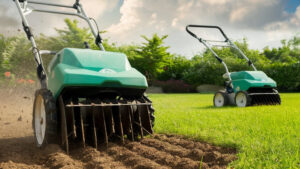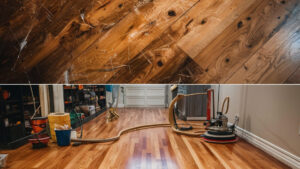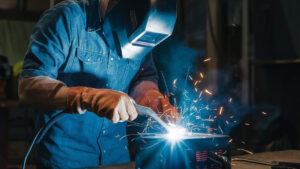Welding rods come in various sizes, each with specific uses. Knowing the right size is crucial for effective welding.
Choosing the correct welding rod size can make a significant difference in your project. Whether you’re a beginner or a seasoned welder, understanding the different sizes and their uses is essential. Welding rods, also known as electrodes, play a vital role in the welding process.
They provide the filler material needed to join metals together. The size of the rod affects the strength and quality of the weld. This guide will help you navigate through the various welding rod sizes and their specific applications. By the end, you’ll have a clear understanding of which rod to use for your specific welding needs.
Introduction To Welding Rods
Welding rods come in different sizes for various uses. Thicker rods are for heavy-duty work, while thinner ones suit delicate tasks. Choosing the right size ensures strong, clean welds.
Are you ready to dive into the world of welding? Understanding welding rods is essential for anyone looking to master this craft. Whether you’re a seasoned professional or a curious beginner, the right knowledge can make all the difference.
Welding rods are the unsung heroes of the welding process. They are the metal sticks or wires that melt to form a strong bond between metal pieces. Different rods are designed for various types of welding, such as arc, MIG, or TIG welding. Each rod has its own unique characteristics, making it suitable for different materials and applications.
What Are Welding Rods?
Welding rods serve as the filler material in welding. When heated, they melt and mix with the base metals to create a joint. Think of them as the glue that holds metal pieces together.
They come in various sizes and compositions, each suited for specific tasks. Some rods are perfect for heavy-duty projects, while others are ideal for delicate work. Knowing which rod to use is crucial for achieving the desired results.
Importance Of Choosing The Right Rod
Choosing the right welding rod can make or break your project. A wrong choice might lead to weak joints, wasted materials, or even safety hazards.
For instance, using a rod meant for steel on aluminum won’t work well. The materials won’t bond properly, and you might end up with a flawed product. So, understanding the properties of different rods is vital.
Don’t underestimate the power of research and testing. Before starting, ask yourself: “Is this the best rod for my project?” Your answer could save you time, money, and frustration.
Remember, the right welding rod is your ticket to a successful weld. Your knowledge and choice can transform a simple metal structure into a work of art.
Types Of Welding Rods
Welding rods come in various types and sizes, each designed for specific applications. Understanding the types of welding rods is crucial for achieving a strong and durable weld. This section will delve into two main categories of welding rods: consumable electrodes and non-consumable electrodes.
Consumable Electrodes
Consumable electrodes, also known as filler rods, melt and become part of the weld. These rods are typically made from materials like steel, aluminum, and nickel alloys. They are essential for filling gaps and joining metal pieces.
One common type of consumable electrode is the E6013, often used for general-purpose welding. It’s versatile, making it suitable for beginners. Another popular choice is the E7018, which provides a stronger weld but requires a bit more skill to handle.
It’s crucial to select the right consumable electrode based on the metal you’re working with. The wrong choice can lead to weak joints and potential failures. Have you ever tried welding thin aluminum with a steel rod? Not a great idea, trust me!
Non-consumable Electrodes
Non-consumable electrodes, like tungsten rods, do not melt during the welding process. They are used primarily in TIG (Tungsten Inert Gas) welding. These rods provide a stable arc and allow for precise control.
Tungsten electrodes come in various types, such as pure tungsten, thoriated tungsten, and ceriated tungsten. Each type has its specific use and benefits. Pure tungsten is great for welding aluminum, while thoriated tungsten is preferred for steel due to its excellent arc stability.
Non-consumable electrodes require a shielding gas, often argon, to protect the weld area from contamination. Have you ever noticed how clean and smooth TIG welds look? That’s the magic of non-consumable electrodes combined with proper shielding.
Choosing between consumable and non-consumable electrodes depends on your project needs and welding technique. What type of welding are you planning to do next? Selecting the right rod can make a significant difference in your results.
Welding Rod Sizes
Welding rod sizes are crucial for efficient welding. The right size ensures strong and durable welds. Choosing the correct rod size affects the quality and performance of your welding project. This guide helps you understand common sizes and how to measure them.
Common Sizes
Welding rods come in various sizes. The most common are 1/16, 3/32, 1/8, and 5/32 inches. Each size serves different purposes. Smaller rods like 1/16 inch are perfect for thin materials. They ensure precision and control. Use 3/32 inch rods for medium thickness. They offer a balance between control and strength. 1/8 inch rods handle thicker materials. They create strong bonds. 5/32 inch rods are ideal for heavy-duty tasks. Their strength supports large-scale projects.
How To Measure
Measuring welding rod size is simple. Use a caliper for accurate results. Place the rod between the jaws. Read the measurement on the scale. Ensure you measure the diameter. This determines the rod size. Knowing the size helps in selecting the right rod for your task. Accurate measurement ensures effective welding outcomes.
Factors Affecting Rod Choice
Choosing the right welding rod is crucial for achieving a strong weld. Several factors influence the selection of the appropriate rod. Understanding these factors helps in making informed decisions. This ensures the weld quality meets the required standards.
Material Type
The type of material being welded is a significant factor. Different metals require different rods. For instance, welding steel often requires a different rod than welding aluminum. Each rod type has unique properties. These properties affect the weld’s strength, appearance, and durability.
Thickness Of Metal
The thickness of the metal also affects rod choice. Thicker metals need a rod that can penetrate deeply. Thin metals require rods that provide precision and control. Using the wrong rod can lead to weak welds or damage to the metal.
Popular Welding Rods And Their Uses
When choosing the right welding rod, understanding the different types and their uses can make all the difference in your projects. Each rod has its own unique characteristics and applications. Below, we’ll take a closer look at two popular welding rods: E6010 and E7018. By the end, you’ll have a clearer idea of which to use for your next welding task.
E6010
The E6010 welding rod is known for its deep penetration. It’s ideal for welding through rust, oil, dirt, and paint. This rod is often used in pipe welding and construction.
E6010 rods are excellent for outdoor work. They perform well in windy conditions, where other rods might struggle. You can count on E6010 for challenging environments.
Another advantage of E6010 is its versatility. It can weld in all positions—flat, horizontal, vertical, and overhead. This makes it a favorite among professional welders.
E7018
The E7018 welding rod is popular for its smooth, strong welds. It’s often used in structural welding and heavy steel construction. This rod is known for producing high-quality welds with minimal spatter.
E7018 rods have a low-hydrogen coating. This reduces the risk of cracking, making it suitable for critical applications. It’s the go-to choice when you need reliable and strong welds.
This rod requires a bit more care. It should be kept dry, as moisture can affect its performance. Using a rod oven to store E7018 rods can help maintain their quality.
Which welding rod do you find most useful in your projects? Share your experiences in the comments below!
Welding Techniques For Beginners
Choosing the right welding rod size is crucial for beginners. Thicker rods handle heavy materials, while thinner rods suit delicate tasks. Understanding these differences ensures a strong, reliable weld for various projects.
Welding Techniques for Beginners
Welding can be an incredibly fulfilling skill to learn. As a beginner, understanding the basics and safety measures is crucial. Let’s dive into some essential techniques and safety tips that can help you get started on your welding journey.
Basic Techniques
Begin with understanding different welding rods. Each type has a specific use and compatibility with various metals. For starters, try using E6013 rods. They are versatile and easier to manage.
Practice laying down simple beads. Hold the rod at a consistent angle, usually about 15 degrees, and move it steadily across the metal. The key is maintaining a constant speed.
Experiment with different types of welds like butt joints and lap joints. Focus on creating clean, even lines. Start with scrap metal to refine your technique without worrying about mistakes.
Safety Tips
Welding involves high heat and bright light, so safety is paramount. Always wear a welding helmet with proper shading to protect your eyes.
Use gloves and long sleeves to shield your skin from sparks and molten metal. Fire-resistant clothing is a good investment.
Ensure your workspace is well-ventilated. Welding fumes can be hazardous. If possible, use a fume extractor or work outdoors.
What challenges have you faced as a beginner? Understanding these basics can make the learning process smoother and safer.
Maintaining Your Welding Rods
Different welding rod sizes serve distinct purposes. Proper storage and handling ensure optimal performance. Keep rods dry to prevent damage.
Maintaining Your Welding Rods
Maintaining your welding rods is crucial for ensuring successful welding projects. Proper care can extend the life of your rods and improve the quality of your welds. Let’s dive into some practical tips that will help you keep your welding rods in top condition.
Proper Storage
Proper storage is essential to maintain the integrity of your welding rods. Always store your rods in a dry place to prevent moisture from affecting them. Consider using a rod oven or a sealed container to keep your rods dry.
Label your containers to avoid confusion. Different rods have different uses, and it’s important to know which one you are grabbing.
Temperature control is also vital. Extreme temperatures can damage your rods. Keep them in a stable environment to maintain their quality.
Handling Tips
Handle your welding rods with care to prevent damage. Dropping or mishandling rods can cause them to bend or break, rendering them useless.
Use gloves when handling rods. This not only protects your hands but also keeps the rods free from oils and dirt that can affect their performance.
Inspect your rods regularly for any signs of damage or wear. Catching issues early can save you time and money in the long run.
Think about how you handle your rods during transportation. Are they securely packed? A little planning can go a long way in maintaining their condition.
Maintaining your welding rods is a small but impactful task. Proper storage and careful handling can significantly improve your welding results. What steps will you take to ensure your rods are always ready for action?
Troubleshooting Common Issues
Choosing the right welding rod size is crucial for successful welds. Thicker rods work well with heavy materials, while thinner ones suit delicate tasks. Understanding rod size impacts weld quality and strength.
Welding can be a rewarding skill, but it often comes with its fair share of challenges. Understanding and addressing common issues can make your projects run smoother. Let’s dive into two frequent problems: porosity and cracking.
Porosity
Porosity in welding refers to the presence of tiny holes or cavities in the weld bead. It can weaken the weld and lead to potential failure.
To combat porosity, ensure your welding rod is clean and dry. Moisture can easily cause this problem.
Another tip is to keep your workspace free from contaminants like oil and rust. These substances can introduce gases into the weld, causing porosity.
Cracking
Cracking is another common issue in welding. It can occur due to rapid cooling or improper technique.
To prevent cracking, preheat your base metal if it’s thick or contains high carbon content. This helps reduce the cooling rate.
Another useful strategy is to maintain a consistent welding speed. Inconsistent speeds can lead to uneven cooling, increasing the risk of cracking.
Have you ever faced these issues in your welding projects? What strategies have you found effective? Share your thoughts in the comments!

Frequently Asked Questions
How Do You Know What Size Welding Rod To Use?
Choose the welding rod size based on the metal thickness, welding position, and current type. Consult rod manufacturer’s guidelines.
What Is 1g, 2g, 3g, 4g, 5g, 6g Welding Position?
1G, 2G, 3G, 4G, 5G, and 6G are welding positions. They indicate the orientation of the weld. 1G is flat, 2G is horizontal, 3G is vertical, 4G is overhead. 5G and 6G positions involve pipe welding, with 5G being horizontal and 6G at a 45-degree angle.
What Is A 6011 Welding Rod Used For?
A 6011 welding rod is used for deep penetration welding, especially on dirty, rusted, or painted surfaces. It’s ideal for repair work.
Is 6011 Or 7018 Easier To Weld?
6011 rods are generally easier to weld for beginners due to their versatility and forgiving nature. They work well on dirty or rusty surfaces and allow for various welding positions. 7018 rods require more skill, as they need a clean surface and are better suited for flat and horizontal positions.
Conclusion
Choosing the right welding rod size is crucial. It impacts the weld quality. Different sizes serve various purposes. Small rods suit light tasks. Large rods handle heavy-duty projects. Always match the rod to the material. This ensures a strong, lasting bond.
Practice helps improve your skills. Experiment with sizes to find the best fit. Remember, safety first. Use protective gear while welding. Understanding rod sizes boosts confidence. It also enhances project outcomes. Keep learning and adapting. This knowledge is valuable in welding.
Happy welding!








